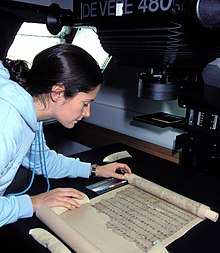List of digital preservation initiatives
Appearance

This is a list of digital preservation initiatives aimed at the digitisation of previously existing media or preserve existing digital archives.
- ABS-CBN Film Restoration Project, an initiative dedicated on the preservation of thousands of Filipino films from ABS-CBN Film Archives.
- ARKive preserves film, video, audio and photographic media on endangered species.
- International Dunhuang Project, an international collaborative effort to conserve, catalogue and digitize manuscripts, printed texts, paintings, textiles and artefacts from Dunhuang and various other archaeological sites at the eastern end of the Silk Road, established by the British Library in 1994.
- Shapell Manuscript Foundation, is a US-based non-profit organization committed to the preservation of historical documents from the 19th and 20th centuries with a focus on the history of the US and the Holy Land. SMF has a large digitized collection of manuscripts available for public view on their web site. SMF is also engaged in collecting and digitizing a comprehensive list of Jewish soldiers who participated in the US Civil War, known as the Shapell Roster Project.
- US National Digital Information Infrastructure and Preservation Program, established in 2000[1] and run by The Library of Congress, is dedicated to ensuring that digital information remains available and accessible.
- Portico, a not-for-profit organization originally launched by JSTOR in 2002, is a digital preservation service which provides "a permanent archive of electronic scholarly journals and books".
- FDsys (Federal Digital System) is a system being developed by the United States Government Printing Office to authenticate, preserve, and provide access to government information from all three branches of the Federal government.
- Elsevier Science digital archive. In 2002, the Koninklijke Bibliotheek became the official digital archive for 7 terabytes of Elsevier Science journals.
- LOCKSS (Lots Of Copies Keep Stuff Safe), established in 1998[1] under the auspices of Stanford University, develops and supports open-source software for digital preservation based on a distributed network of preservation appliances running a sophisticated voting protocol. Originally designed to preserve scholarly journals, the LOCKSS technology is now being used to preserve electronic theses and dissertations, government documents, books, blogs, websites, image collections, etc. The LOCKSS Program also runs its own preservation network.
- The MetaArchive Cooperative is a library-run, collaborative approach to digital preservation that embeds digital preservation infrastructure and knowledge in each of its constituent member institutions. Composed mainly of University libraries, the Cooperative functions as a network wherein each preserved file is replicated seven times, is stored in geographically distinct locations across four countries, and is carefully managed from ingest (as a SIP) to dissemination (as a DIP).
- National Digital Heritage Archive, is a program that is a partnership between the National Library of New Zealand, Ex Libris Group, and Sun Microsystems to develop "Rosetta" a digital archive and preservation management system. Established in 2004, the program was launched in late 2009.
- Canadiana.org is a non-profit alliance of major memory institutions in Canada providing access to digitized Canadian documentary heritage.
- DSpace is an open source software that essentially takes data in multiple formats (text, video, audio, or data), distributes it over the web, indexes the data (for easy retrieval), and preserves the data over time.
- PADI (est. 1996)[1] is a comprehensive archive of information on the topic of digital preservation from the National Library of Australia.
- The Digital Preservation Coalition (est. 2001)[1] is a non-profit organization which seeks to secure the preservation of digital resources.
- WikiTeam, volunteers group which has preserved over 4,500 wikis.
- Digital preservation program at Rhizome, which develops products like Webrecorder and Oldweb.Today, free, open-source tools for web archiving and the re-performance of legacy born-digital cultural materials.[2][3]
- The Computerspielemuseum Berlin is a cooperative partner of the EU research project ''PLANETS (Preservation and Long-term Access through Networked Services). Besides that, it is also a contributor to the EU research project Keeping Emulation Environments Portable, also a digital media preservation research project.
- RODA is an open source digital preservation repository that delivers functionality for all the main units of the OAIS reference model. RODA is capable of ingesting, managing and providing access to the various types of digital content produced by large corporations or public bodies. RODA is based on open-source technologies and is supported by existing standards such as the OAIS, METS, EAD and PREMIS.
- The Open Preservation Foundation (formerly the Open Planets Foundation) is a non-profit membership organisation which sustains technology and knowledge for the long-term management of digital cultural heritage, providing its members with reliable solutions to the challenges of digital preservation.
- The Econstor is a non-profit digital archiving service by German National Library of Economics – Leibniz Information Centre for Economics (https://www.econstor.eu/dspace/about). ECONSTOR aims to permanently preserve the literature in economics and related fields like management, business and social sciences (http://blog.repec.org/2011/09/15/econstor-a-repec-archive-for-research-from-germany/). ECONSTOR also provides free open access publication platform for researchers in the journal areas of management, economics and social sciences. Many publishers now prefer ECONSTOR to preserve and archive their digital contents (http://ijmess.com/whyijmess.php).
- The Archive Team archives data on various websites and online services.
- The FP7 DURAFILE Project (http://durafile.eu). The DURAFILE project (based on a FP7 initiative under grant agreement n° FP7-SME-2013-605356) aims to offer a novel software platform preserving both personal digital information and the digital information generated by organizations. This is the first attempt to bring Digital Preservation to home users and small-medium size companies
See also
References
- ^ a b c d Cornell University Library (2003). "Digital Preservation and Technology Timeline". Digital Preservation Management. USA. Retrieved August 2015.
{{cite web}}: Check date values in:|accessdate=(help) - ^ Rose, Frank (23 October 2016). "The Mission to Save Vanishing Internet Art". New York Times. Retrieved 4 November 2016.
- ^ Goel, Vindu (19 October 2014). "A Dynamic New Tool to Preserve the Friendsters of the Future". New York Times. Retrieved 4 November 2016.
